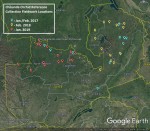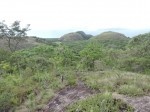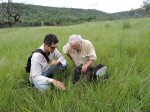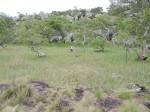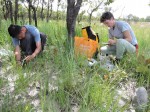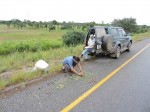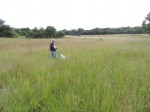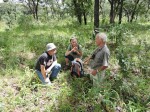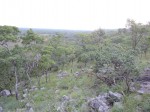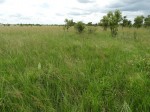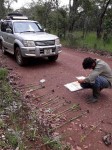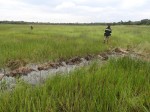Expedition no. 58: The Chikanda Orchid Conservation Initiative (COCI) : 20 Jan 2017-12 Jan 2019
The Chikanda Orchid Conservation Initiative (COCI) was started to help conserve and sustain the remaining wild populations of a group of terrestrial orchids that are used as an ingredient in the preparation of a local foodstuff known as Chikanda in Zambia, Chinaka in Malawi and Kinaka in Tanzania. The increasing popularity for Chikanda in Zambia has put greater pressure on populations of Disa, Habenaria and Satyrium species predominately and to a lesser extent species of Brachycorythis, Platycoryne and Roeperocharis across south central Africa, where the orchids are harvested in large quantities to feed a growing demand in Zambia. Funding for the COCI was provided by the Darwin Initiative in the UK under the project “Edible wild orchid trade: sustaining livelihoods and biodiversity in Zambia” (Project Ref. 23-034). It ran from the start of June 2016 to the end of May 2019 and was administered through RBG, Kew (UK) in association with project partners at Copperbelt University (Zambia), Sanga Research & Development (Zambia), Agents of Change Foundation (Zambia), Homegarden Landscape Consultants Ltd. (Zambia), Uppsala University (Sweden), Cape Institute of Micropropagation (South Africa) and Orchid Seed Science and Sustainable Use (UK).
Photo: Nicholas Wightman
Mutinondo inselberg landscape. Habitat: Miombo woodland, inselbergs and rocky seepage slopes. Location: Mutinondo Wilderness Lodge, Mpika District, Muchinga Province
Photo: Kazutomo Yokoya
Nick and Mike at 80 mile dambo. Habitat: perennial wet dambo. Location: 80 mile dambo/Chakwenga Headwaters, Rufunsa District, Lusaka Province
Photo: Nicholas Wightman
Ruth and Kaz at Kapishya. Habitat: rocky woodland and seepage dambos. Location: Kapishya Hotsprings, Chinsali District, Muchinga Province
Photo: Nicholas Wightman
Ruth and Kaz taking notes near Kasama. Habitat: open Uapaca wooded grassland. Location: Love'N'Light Lukupa, Kasama District, Northern Province
Photo: Nicholas Wightman
Benny and Francisco with specimens. Habitat: riverside dambo/flooded grassland. Location: Mibanga area, Kasama District, Northern Province.
Photo: Nicholas Wightman
Benny in dambo above Kundalila Falls. Habitat: perennial wet dambo. Location: Kundalila Falls, Serenje District, Central Province
Photo: Nicholas Wightman
Benny, Sue and Dave in Mkushi farm block wooded area. Habitat: Miombo woodland. Location: Moffat Farm, Mkushi Farm Block, Mkushi District, Central Province.
Photo: Nicholas Wightman
Namutoya wooded rocky hills. Habitat: Rocky miombo woodland. Location: Namutoya area, Serenje District, Central Province.
Photo: Nicholas Wightman
Mufumbwe Plain. Habitat: Open dambo/grassland. Location: Mufumbwe Plain, Mufumbwe District, North-Western Province.
Photo: Innocent Kabinda
Nick making specimen notes near Chimfunsi. Habitat: Miombo woodland. Location: Chimfunsi, Chingola District, Copperbelt Province.
Photo: Nicholas Wightman
Nyikongola Dambo. Habitat: perennial wet dambo. Location: Chimwishi area, Mwinilunga District, North-Western Province.
Generate a list of species for Expedition no. 58
Description
Through efforts to increase education, research and conservation, it is anticipated that the decreasing populations of these wild orchids will be stabilized and that a sustainable commercial Chikanda growing industry will be established thereby safeguarding the remaining populations of the orchids in the wild. Project activities included market survey and supply chain analysis work to understand the market trade and economics from harvesting communities through to the end consumer. DNA barcoding work by an MSc student attempted to identify species from tubers bought in the marketplaces of urban Zambia with his thesis adapted for publication in the scientific journal Genes (Trade in Zambian Edible Orchids – DNA Barcoding Reveals the Use of Unexpected Orchid Taxa for Chikanda). Work by Copperbelt University has focused on participatory planning exercises with three remote communities in north-western Zambia to produce a community based orchid conservation plan to help reduce over harvesting of the wild populations and eliminate wasteful harvesting of juvenile material.
The project has also involved ex-situ conservation activities with in-vitro seed propagation efforts in labs at RBG, Kew and Copperbelt University’s School of Natural Resources using both asymbiotic and symbiotic culture media in the development of seed germination protocols. Zambian orchid mycorrhizal fungi strains were isolated and cultured by Kew researchers in the first year of the project to enable symbiotic culture. Seed from plants collected in the wild as well as from hand pollinations done by the Project Manager from Chikanda orchid tubers bought in the marketplaces and flowered at his farm have led to the production of over 25,000 asymbiotic and symbiotic seedlings by the close of the project. These seedlings will continue to be grown on at Copperbelt University and form the basis of breeding efforts for eventual domestication and commercialization plans; thereby, easing the harvesting pressure on existing wild populations.
Finally, documenting which species still grow in the rural and peri-urban areas of northern Zambia has also been instrumental in establishing a modern baseline of species distribution. The last major collections of orchid voucher specimens in Zambia date back to the 1960’s and 70’s carried out mainly by the late Dr. Graham Williamson. Much has changed across the landscape since then due primarily to population expansion and land-use change, in addition to the rise in popularity of Chikanda in urban centers of Zambia during the last three decades. The project organized three reference collection fieldwork trips to the northern parts of Zambia in the orchid’s growing season between January and February. The 2017 trip involved the Project Leader, Dr. Ruth Bone, from Kew and her colleague, Dr. Kazutomo Yokoya, and the Project Manager, Nicholas Wightman, for fieldwork that covered north western and north eastern parts of Zambia. Fieldwork in 2018 saw the participation of Dr. Benny Bytebier, the Curator at Bews Herbarium at University of Kwa-Zulu Natal in Peitermaritzburg along with Peace Corps volunteer Francisco Llarena and Nicholas Wightman traveling up to north eastern Zambia. The last trip in 2019 involved the Garden Manager of Munda Wanga Environmental Park, Innocent Kabinda, translator, Nebert Ngoma and Nicholas Wightman for fieldwork concentrating on north western Zambia. In total, 185 collections were made mostly of the target Chikanda genera Brachycorythis, Disa, Habenaria, Platycoryne and Satyrium with final species determinations carried out by Dr. Benny Bytebier. Herbarium specimens were only made from populations of greater than 10 individuals with duplicates or triplicates collected if populations totaled greater than 50 individuals. In addition to herbarium specimens, leaf samples were taken for DNA extraction and spirit collections were made to preserve the structure of the flowers. The specimens are lodged in herbaria at Kew (K), Kitwe (NDO) and Bews (NU).
